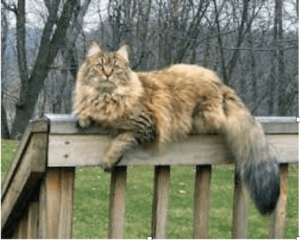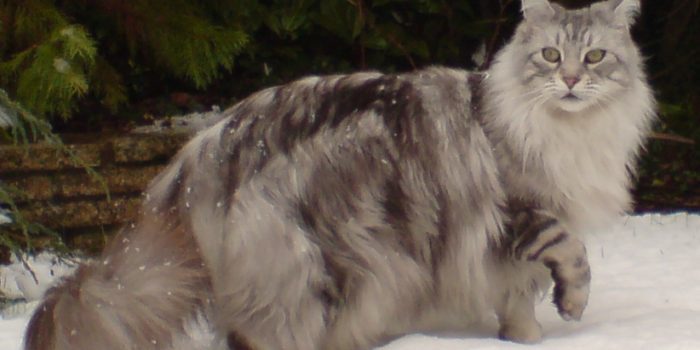Fluffy, adorable and a great pet- the Maine Coon is the biggest trained type of cat. It has an unmistakable physical appearance and profitable chasing aptitudes. It is one of the most seasoned regular breeds in North America, particularly “local” to the condition of Maine (however the cat was just presented there) where it is the official state feline.
Maine coons have been loved as a pet by many! But, there are a few facts about the Maine Coon that people are not aware of. This article will highlight facts about the maine coone that will help all cat lovers understand the animal even more!
The weight of the pet is concern for many pet owners as it depicts their health. A full-developed female normally weighs between 9-12 pounds, and guys have a tendency to be in the 13 to 18-pound range.
Also, your cleaning worries can rest as Maine Coons needn’t bother with much preparing and a week after week brushing is all that is usually required to keep the coat in top condition.
Some “unique” Maine Coons were polydactyls (had extra toes). Be that as it may, advanced thoroughbred Maine Coons are infrequently polydactyls. This is on the grounds that all feline affiliations naturally preclude polydactyls from rivalry in the thoroughbred classes. As a result of this, most polydactyls were winnowed from the Maine Coon breed decades back, and just a couple of reproducers keep on working with them. Since the polydactyl quality is predominant, you can’t get a polydactyl cat unless no less than one of the guardians is likewise a polydactyl.

The Maine Coon is America’s local longhair feline; it developed actually in light of the New England atmosphere. Your feline’s precursors may be like the felines that established the Maine Coon breed. Be that as it may, it’s difficult to tell from simply taking a gander at your feline on the off chance that it is identified with the Maine Coon or to some other breed. Since the Maine Coon is a particular breed and hasn’t been reproduced to extremes, there are felines everywhere throughout the world that look like the Maine Coon. The best way to tell without a doubt if your feline is a Maine Coon is to take a gander at the family.
Maine Coons arrive in a wide assortment of shading blends. The main hues you won’t discover are the Siamese-sort hues.
Physical Features | Facts
The vital elements of the Maine Coon are the head and body shape, and the composition and “shag” of the coat. The head is somewhat more than it is wide, introducing a tenderly curved profile with high cheekbones and ears that are extensive, wide at the base, reasonably pointed, and very much tufted inside. They are set well up on the head, around an ear’s width separated. Lynx-like tufting on the highest point of the ears is alluring. The neck ought to be medium-long, the middle long, and the mid-section expansive. The tail ought to be at any rate the length of the middle. One of their most particular elements is their eyes, which are substantial, round, expressive, and set a somewhat sideways edge. Generally, the Maine Coon ought to introduce the presence of a very much adjusted, rectangular feline.

All through their history there has been no confinement on the examples and hues adequate, except for the pointed Siamese example. Thus, an extensive variety of hues and examples are reproduced. Eye hues for all coat hues range through green, gold, and green-gold. Blue eyes and odd eyes, (one blue and one gold eye) are reasonable in white felines. There is no prerequisite in the Maine Coon Standard of Perfection for specific blends of coat shading and eye shading.
Maine Coon proprietors appreciate the breed’s trademark joker like identity, delicate nature, entertaining propensities, and traps, ability to “help” with any action, and effectively prepped coat. They make fantastic sidekicks for strong, dynamic families that likewise appreciate having mutts and different creatures around. Their solidness and simplicity of kittening make them a delightful initially breed for the learner raiser. For proprietors wishing to appear, the Maine Coon has recovered its unique radiance in the show ring.
The Maine Coon is an extensive and friendly feline, henceforth its epithet”the gentle giant”. It is described by a rectangular body shape, strong bone structure, a long, ragged tail and a velvety streaming coat. The animal’s hues fluctuate broadly, with just chocolate and lilac. Presumed for its insight and lively, tender identity, the Maine Coon is frequently referred to as having “pooch like” characteristics. Professionals see certain well-being issues which include hypertrophic, hip dysplasia and cat cardiomyopathy, yet legitimate reproducers use advanced screening strategies to ensure minimal recurrence of the problems mentioned.
Maine Coons were settled over a century prior as a strong, great looking type of local feline, very much prepared to withstand the harsh winters of New England. Nature can not be kind-hearted all the time. Talking about survival of the fittest; it chooses the greatest, the the best contenders, brightest and the best seekers to breed progressive eras. Arranged nurturing of Maine Coons are moderately later. Since arranged rearing started, Maine Coon raisers have tried to safeguard the Maine Coon’s “regular,” rough qualities. The perfect Maine Coon is a solid, sound feline.
Strangely, the Norwegian Forest Cat is a breed very close to the Maine Coon, which, albeit topographically inaccessible, advanced in much the same atmosphere, and loans trustworthiness to the hypothesis that a portion of the felines in charge of building up the Maine Coon were adopted and brought up by the Vikings.
Everything about the Maine Coon focuses to its adjustment to a brutal atmosphere. It’s coat is glossy, overwhelming and water-safe, a resemblance found in no other breed, and should be felt to be welcomed. It is longer on the stomach, britches and ruff, stomach to secure against the dampness caused by snow or rain and shorter on the back and neck to make sure it doesn’t tangle in bushes. The coat has a gentle fall and is practically upkeep free: a week after week brushing is all that is typically required.
The ragged, long tail which the feline wraps around itself when it twists up to rest can shield him from frosty winters. The ears are all the more intensely furred than numerous breeds for assurance from the chilly and have an extensive scope of development. Huge, tufted, round; the really cute feet act as ‘snow shoes.’ They have huge eyes and ears that are survival characteristics, serving the purpose of expanded sight and hearing. The moderately long, square gag encourages getting and handling preys and to lap water from puddles and streams.
It is very important to know that Yankee myth of 30-pound felines is only an unusual myth! These animals are without any doubt tall, strong, enormous bone felines; but males, they generally weigh 13 to 18 pounds, with females regularly weighing around 9 to 12 pounds.
Maine Coons grow gradually and don’t accomplish their full weight and size until their age is three to five years old. Throughout their lives, they display a kittenish attitude. They are enormous, tender, pleasant goofs.
Indeed, even their voices are a differentiating factor when compared to other-felines; they have an unmistakable, tweeting mantra which they use for everything from seeking to coaxing their kin into giving attention to them. (Maine Coons affection to play, and numerous will blissfully recover little things) They seldom bowl, and when they do, that delicate, the small voice doesn’t fit their size! They definitely will melt anyone away with their playful attitude.
Main Coons facts: Traits
While Maine Coons are exceptional individuals situated felines, they are not excessively reliant. They don’t always bother you for consideration, however, like to “hang out” with their proprietors, exploring whatever action you’re required in and “helping” when they can. They are not when in doubt, known as “lap felines” however as with any identity attribute there are a couple Maine Coons that favor laps. Most Maine Coons will remain nearby, likely possessing the seat by yours. Maines will tail you from space to room and sit tight outside a shut entryway for you to rise. A Maine Coon will be your friend, your amigo, your buddy, yet scarcely ever your child.
Maine Coons are casual and nice in pretty much all that they do. The guys have a tendency to be the comedians while the females hold more nobility. However both stay perky for the duration of their lives. They, for the most part, coexist well with children and puppies, and in different addition felines. They are not as vertically-situated as some different breeds, preferring to pursue objects on the ground and getting a handle on them in their enormous paws – most likely senses created as expert mousers. Numerous Maine Coons will play “get” with their proprietors.
Maine Coons Caring And Medical Aspect facts
Most breeders suggest a brilliant dry sustenance. Most felines can free nourish without getting to be overweight. Moderately aged felines (5-10) are well on the way to have weight issues which can more often than not be controlled by changing to a low-calorie nourishment. Numerous Maine Coons love water. Keep a decent supply of pure, crisp water accessible at all times.
Most Maine Coons can be prepared to acknowledge a rope. Maine Coons are animals of propensity, and they prepare effortlessly on the off chance that they relate the action with something they need (they prepare people effectively as well!).
People inside any breed are decently firmly related and have numerous attributes in like manner. This incorporates innate qualities and shortcomings. Certain hereditary wellbeing issue might be pretty much of a matter in a specific breed than in different breeds. For instance, a breed may have a marginally higher rate of gum infection than the feline populace overall, yet have a lower frequency of coronary illness or liver malady.
Hereditary issues for the most part just influence a small minority of the breed, all in all, however since they can be annihilated via careful screening, most trustworthy raisers attempt to track such issues, both in their rearing stock and the cats they deliver. By working with a mindful reproducer who will talk straightforwardly about wellbeing issues, you are empowering sound rearing practices.
In the Maine Coon, the most widely recognized acquired wellbeing issues are hip dysplasia, which can deliver faltering in an extremely influenced feline, and cardiomyopathy, which can create anything from a minor heart mumble to serious heart inconvenience. Any reproducer you converse with ought to will to examine whether they’ve had any issues with these ailments in their rearing stock, or in little cats they’ve created; the amount of screening they’re doing, and why. Legitimate consideration of your Maine Coon, including dialog of these wellbeing issues, requires building up a decent working association with your veterinarian.


